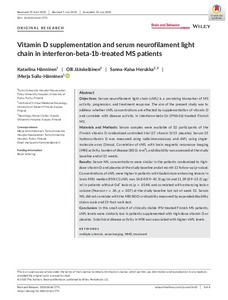Vitamin D supplementation and serum neurofilament light chain in interferon-beta-1b-treated MS patients
Olli Jääskeläinen; Katariina Hänninen; Merja Soilu‐Hänninen; Sanna‐Kaisa Herukka
Vitamin D supplementation and serum neurofilament light chain in interferon-beta-1b-treated MS patients
Olli Jääskeläinen
Katariina Hänninen
Merja Soilu‐Hänninen
Sanna‐Kaisa Herukka
WILEY
Julkaisun pysyvä osoite on:
https://urn.fi/URN:NBN:fi-fe2021042824813
https://urn.fi/URN:NBN:fi-fe2021042824813
Tiivistelmä
Objectives: Serum neurofilament light chain (sNfL) is a promising biomarker of MS activity, progression, and treatment response. The aim of the present study was to address whether sNfL concentrations are affected by supplementation of vitamin D and correlate with disease activity in interferon-beta-1b (IFNb-1b)-treated Finnish MS. Materials and
Methods: Serum samples were available of 32 participants of the Finnish vitamin D randomized controlled trial (17 vitamin D/15 placebo). Serum 25 hydroxyvitamin D was measured using radioimmunoassay and sNfL using single-molecule array (Simoa). Correlation of sNfL with brain magnetic resonance imaging (MRI) activity, burden of disease (BOD, mm(3)), and disability was assessed at the study baseline and at 52 weeks.
Results: Serum NfL concentrations were similar in the patients randomized to high-dose vitamin D and placebo at the study baseline and at month 12 follow-up (p-value). Concentrations of sNfL were higher in patients with Gadolinium-enhancing lesions in brain MRI: median (95% CI) sNfL was 14.84 (9.9-42.5) pg/ml and 11.39 (8.9-13.2) pg/ml in patients without Gd(+)lesions (p = .0144) and correlated with enhancing lesion volume (Pearsonr = .36,p = .037) at the study baseline but not at week 52. Serum NfL did not correlate with the MRI BOD or disability measured by expanded disability status scale and 25-foot walk test.
Conclusion: In this small cohort of clinically stable IFN-treated Finnish MS patients, sNfL levels were similarly low in patients supplemented with high-dose vitamin D or placebo. Subclinical disease activity in MRI was associated with higher sNfL levels.
Kokoelmat
- Rinnakkaistallenteet [19207]
